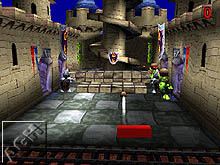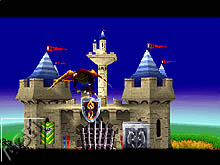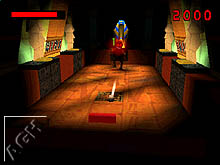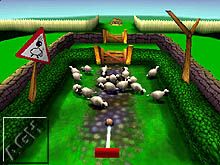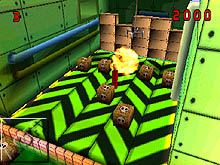|
After the success that Pong enjoyed on the PC
and Sony PlayStation, it was only a matter of time until its
close cousin -- Breakout was revived by Atari.
Thankfully, this game has been updated nicely and should
please both classic gaming fans and newly christened game-players
alike.
In Breakout, our hero breaks free from his cell
and sets upon a path to rescue his Bat and Ball friends, destroy
the Evil Pung and rescue the curvaceous Ping. Guess what the
hero's name is. You guessed it, it's Pong! The game has you
taking control across ten different locales from a Dark Prison
cell to a Dragon-owned castle, a gadget laden laboratory to the
Stormy Seas. Gamers can expect to be wowed by constant surprises,
chased down by a giant wolf, finally knocking down that leaning
Tower of Pisa, descending into the dark depths of a mysterious
Egyptian tomb and going head-to-head with a Red Dragon (no, it's
nothing like the "duck" in 2600 Adventure. Hey,
now there's a great game that should be updated!.) However, once
the evil Pung is destroyed and the world is made safe again, the
destruction continues. When home alone, countless challenge modes
open up secrets and bonuses. When friends abound, you can challenge
them to a neat multiplayer gamefest.
The developer of Breakout is Supersonic Software, the same team
responsible for the critically acclaimed Pong. Given how Breakout
is similar in play mechanics to Pong, and considering the amount of
care and effort that Supersonic put into the latter, you would
expect that the revamped Breakout would offer simple gameplay with
the depth and technological excellence demanded by today's game
players. Breakout is both mouse and JogCon compatible -- something
that Pong could have sorely used. Up to four players can enjoy the
game with the PSX multitap adapter.
The standard one-player game has a strong narrative structure -
with the story line fleshed out and tied to the gameplay.
After the intro story, the game opens with Pong in his prison
cell. He must use his "Breakout" skills to escape this jail and
in doing so he completes the first chapter of our tale.
From here on the game is made up of "chapters." These are
like short stories in that they do not have to be "read" (or
played) in a particular order. What they have in common is
that Pong must play through them towards their conclusion of
him rescuing one of his imprisoned friends and gaining a reward.
The final chapter of the game involves Pong using all his skills
and powers he has gained during the rest of the game to defeat
the evil Pung and rescue Ping.
In the Challenge Play, a number of levels from each chapter
is designed in such a way that a variety of games can be played
in it. Typically this will involve tweaking various aspects of
gameplay (number of blocks, number of balls, etc.) and adding
new elements. The player will be able to go back to any level
he has beaten during the narrative of the game to play these
other variations. The one player game will involve 8-10 chapters
(including intro and end game), around 20-30 unique levels and
upwards of 60-100 unique challenges available duriing "Challenge
Play." Finally, in addition the player will be able to play
classic arcade "Breakout." This will be accessible "out of the
box" and will include additional "museum" information about the
game.
As the player progresses through Breakout, he will be rewarded
with bonus bats and balls. These can be used in subsequent levels,
bringing a further depth to the gameplay. Pong, as well as moving,
can on occassion during a level bring in one of his rescued friends
to help for a limited period of time. Hitting a "gold brick" activates
these. On hitting a gold brick you get an opportunity to swap to one
of your "reward" bats or balls. When you choose to use a bonus ball
or bat, they are, of course, only active for a limited period of time.
The real treat, however, happens when four players simultaneously
join in on the action, choosing from two different competitive modes.
The first type has split-screen levels and requires the foes to
simultaneously clear their arenas while also having to attack their
opponents by sending over blocks. All on-screen levels involve Pong-like
gameplay, where opponents must simultaneously defend their blocks while
attacking their opponents.
Basically, if you enjoyed Pong, Breakout will provide you with similar
thrills. The game has kept the same whimsical nature of Pong, and the
elements which made Pong so popular are also carried over in Breakout.
|
Title |
Breakout |
|
Publisher |
Atari |
|
System |
Sony Playstation |
|
Graphics |
7 |
|
Sound |
6 |
|
Gameplay |
8 |
|
Overall |
8 |
|
Reviewer |
Keita Iida |
|
